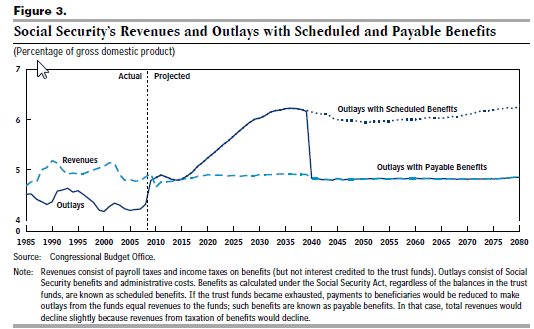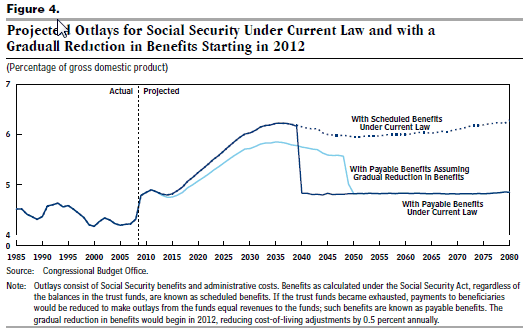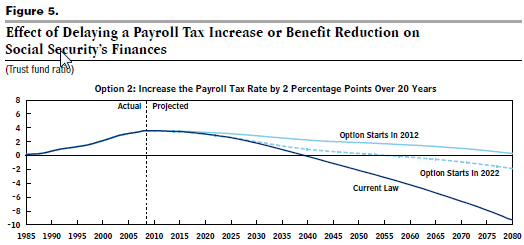The three most important numbers in the Social Security reform debate are as follows: 218, 60 and 1. That is the number of votes any reform plan must receive in the House, the Senate and the White House to become law. One barrier to doing the politically hard work of agreeing to a Social Security reform is the fact that we can continue paying scheduled benefits for another quarter of a century even with no reform. A year ago, this plus the fact that health care costs are a bigger source of the long term deficit would have led me to say that we should deal with health care costs first and that we have time to address the real shortfalls of Social Security later. I have changed my mind, and think that addressing Social Security sooner rather than later should be a top priority. In part, I changed my mind because of the current impasse over health care reform, and the likelihood that it will be very difficult (impossible) to get any further movement ahead on addressing health care costs until after the legal challenges to the individual mandate are completed. In addition, studying some basic charts from the Congressional Budget Office (CBO) helped to convince me that we need to act sooner, rather than later on Social Security in order to avoid the drastic nature of the fixes that will be required the longer we wait to act. Three basic charts from the CBO’s July 2010 document on policy options for Social Security will help me to illustrate.

Figure 3 shows the projected revenues (dashed blue line) and scheduled Social Security benefits (dark blue line) from 2009 until 2080. This figure shows the default Social Security fix, which is a large across the board benefit cut somewhere around 2037. This will be triggered under current law when the revenues flowing into the program are less than the benefits flowing out, and there are no longer any governmental securities that were bought over the past 25 years when revenues were greater than benefits, to make up the difference. When this takes place, current law says that benefits will have to be cut to make the taxes flowing in match the benefits flowing out each year. Several things about this graph. First, with no change to benefits or taxes, the benefit cut required in 2037 or so would be very large (the near vertical line dropping by about 1% of GDP in 2037). This would be a tremendous benefit cut for beneficiaries, many of whom are dependent upon Social Security for a large portion of their income. Second, 2037 is 26 years away, which is not right around the corner. It is true we could do nothing this year, and it wouldn’t make that much difference. However, if you delay in this manner (wait until next year!) for another decade or so, then you are halfway to the very large drops with less time to implement an alternate change.
The next figure (Figure 4 from the CBO report) demonstrates what taking some immediate action (in this case reducing scheduled benefits starting in 2012) does to the problem–it both pushes further into the future the point at which a large benefit drop will occur, and it also makes the size of the necessary drop smaller. It is true that Figure 4 demonstrates a strategy of making smaller cuts now to avoid bigger ones in the future. However, something must be done, and beginning to act sooner would smooth out the changes which, in turn, will give people more time to plan. This seems preferable to me. My point here is not to argue for a particular Social Security reform option, just to demonstrate that beginning to act now is important to avoid the most jarring changes later.
 The final figure (Figure 5) more clearly demonstrates the effect of starting a policy earlier, as opposed to later. The reform option shown is a 2 percentage point increase in the Social Security payroll tax (phased in slowly), and the 3 lines show the long range impact on the ability of Social Security to pay benefits if the payroll tax increase begins in 2012, 2022 and then what happens if it is not increased. Under current law and no change, the scheduled benefits are larger than payroll taxes and all trust fund securities will have been redeemed around 2037 (dark blue line) meaning that benefits will have to be cut sharply in order for revenues to match outlays. This is the same story told on the other two graphs, just in a slightly different way. However, if an eventual 2 percent increase in the payroll tax were started in 2012 (light blue solid line), then Social Security would be solvent until 2080, meaning it could pay the scheduled benefits for the next 69 years because of the imposition of this tax increase starting in 2012. If the same size payroll tax increase were delayed a decade and begun in 2022, then Social Security would be solvent and able to pay scheduled benefits until around 2055, at which point a steep benefit cut would be necessary without further action. Thus, a delay of a decade in beginning a slow tax increase reduces the ability of Social Security to pay scheduled benefits by 25 years.
The final figure (Figure 5) more clearly demonstrates the effect of starting a policy earlier, as opposed to later. The reform option shown is a 2 percentage point increase in the Social Security payroll tax (phased in slowly), and the 3 lines show the long range impact on the ability of Social Security to pay benefits if the payroll tax increase begins in 2012, 2022 and then what happens if it is not increased. Under current law and no change, the scheduled benefits are larger than payroll taxes and all trust fund securities will have been redeemed around 2037 (dark blue line) meaning that benefits will have to be cut sharply in order for revenues to match outlays. This is the same story told on the other two graphs, just in a slightly different way. However, if an eventual 2 percent increase in the payroll tax were started in 2012 (light blue solid line), then Social Security would be solvent until 2080, meaning it could pay the scheduled benefits for the next 69 years because of the imposition of this tax increase starting in 2012. If the same size payroll tax increase were delayed a decade and begun in 2022, then Social Security would be solvent and able to pay scheduled benefits until around 2055, at which point a steep benefit cut would be necessary without further action. Thus, a delay of a decade in beginning a slow tax increase reduces the ability of Social Security to pay scheduled benefits by 25 years.
My primary point here is not to argue for a given Social Security fix, but to argue for one to be developed sooner, rather than later. By acting now with either benefit cuts, tax increases or most likely a mixture of the two, we will signal our seriousness on the deficit and can begin addressing the long range problems of Social Security. We will be able to ease into changes over longer periods of time, and not face the very large and sudden benefit cuts that would be required with no action. Action taken now will allow people to plan for the future. The longer we wait, the fewer options we will have, and the more painful they will likely be for the most vulnerable and dependent upon Social Security. Most people say there is no way we would allow the large benefit cuts in Social Security that will be required in 2037 if no action is taken, and I think I agree. However, at some point we will have to take action to turn this general sentiment into a reality. We should develop a compromise proposal and act now.
Update: I clarified that CBO scenario option 2 (Fig. 5) is a 2 percentage point increase in the payroll tax rate that would gradually begin in 2012, or 2022, and rise by 0.1% per year (0.05% employer/0.05% employee) per year until the full 1%employer/1% employee increase was realized.


